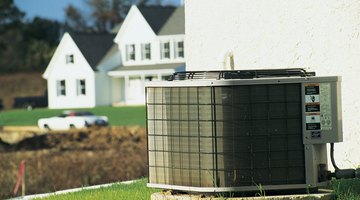How to Fix an AC Compressor
Fixing AC compressor problems increases the unit's efficiency and extends its life. An AC compressor contains a motor with start and run windings. The motor turns a piston that compresses the system's refrigerant.

Because of the high-pressure load the piston creates during startup, the motor uses its start windings to reach full speed. The amperage load an air conditioning compressor draws throughout its start phase burns loose-fitting wire terminals. A failing run capacitor increases the amperage draw during both the compressor's start and run phase.
Things You Will Need
- Screwdriver set
- Capacitor
- Needle-nose pliers
- Multimeter
- Compressor terminal repair kit
- Hard-start capacitor
Warning
Only EPA certified technicians can legally check refrigerant pressures.
-
Turn off the AC system's condensing unit circuit breaker, usually located in the electrical panel next to the building's electric meter. The correct circuit breaker uses an "Air Conditioner," "AC" or "Heat Pump" label.
-
Open the condensing unit's electrical panel and its compressor cover, using the correct screwdriver. The electrical panel mounts to the side of the condensing unit where the wires enter the unit. If the unit's fan mounts on the compressor's cover, remove the screws holding the cover in place and rotate the cover to the side of the unit. The fan uses long wires that allow access to the compressor without disconnecting the wires from the fan relay.
-
Inspect the compressor's capacitor, located in the condenser's electric panel. The compressor capacitor looks like an oval or round galvanized-metal cylinder with wire terminals exiting its lid. If the capacitor has a swollen or leaking lid, replace the capacitor with an exact replacement model. Replacement capacitors must have the same capacitance and voltage ratings.
-
Pull the wires from the compressor capacitor's wire terminals, using needle-nose pliers to grip the wire connectors. Notice the wire from the condenser's contactor connects to the capacitor terminal with the "Com" label and the wire from the compressor attaches to the capacitor's "Herm" terminal.
-
Turn a multimeter to its capacitance setting. Hold a multimeter lead on each capacitor terminal and compare the multimeter's readout to the capacitor's capacitance rating, as stated on the capacitor's identification sticker. The multimeter's readout must remain within 10 percent of the capacitor's rating. If not, replace the capacitor. Return the condenser's wires to their respective spots on the capacitor.
-
Slip a slotted screwdriver into the small slot on the side of the AC compressor's wire terminal cover. Pry the cover off the compressor with the screwdriver.
-
Inspect the wire connectors attached to the compressor's wire terminals. If the terminals look burnt or do not grip the terminals tightly, replace the wire connectors with a compressor terminal repair kit. Follow the terminal repair kit's instructions, paying special attention to the kit's wire-splice instructions. Replace the compressor's terminal cover.
-
Replace the condenser's compressor cover. Tighten the cover's retaining screws, using the correct screwdriver.
-
Turn the multimeter to the amperage setting. Clamp the multimeter's amp-probe over the black-colored wire leading to the compressor's common terminal.
-
Find the condenser's "LRA" and "RLA" ratings on the condenser's identification label. The LRA ("Lock Rotor Amps") rating gives the condenser's maximum startup amperage. The RLA ("Rated Load Amps") rating gives the condenser's equipment run amperage.
-
Turn on the condenser's circuit breaker and watch the multimeter's readout. The multimeter's readout should approach the condenser's LRA rating. Once the compressor reaches full speed, the multimeter's readout should drop to the condenser's RLA rating. Turn off the condenser's circuit breaker. If the multimeter's startup readout exceeds the condenser's LRA ratings, install a hard-start capacitor across the compressor's run capacitor terminals, using the hard-start capacitor's instructions. If the hard-start capacitor does not solve the high LRA readout, replace the compressor. If the compressor has a high RLA readout, check the system for a high refrigerant level. If the compressor has a low RLA readout, check the system for a low refrigerant level. If the compressor does not show any amperage, troubleshoot the contactor and the defrost circuit board.
The Drip Cap
- Fixing AC compressor problems increases the unit's efficiency and extends its life.
- An AC compressor contains a motor with start and run windings.
- A failing run capacitor increases the amperage draw during both the compressor's start and run phase.
- Inspect the compressor's capacitor, located in the condenser's electric panel.
- Turn a multimeter to its capacitance setting.
- The multimeter's readout must remain within 10 percent of the capacitor's rating.
- If the terminals look burnt or do not grip the terminals tightly, replace the wire connectors with a compressor terminal repair kit.
- Replace the condenser's compressor cover.
- The LRA ("Lock Rotor Amps") rating gives the condenser's maximum startup amperage.
- If the compressor has a low RLA readout, check the system for a low refrigerant level.
References
Resources
Writer Bio
Based out of Central Florida, Robert Sylvus has been writing how-to and outdoor sports articles for various online publications since 2008. Sylvus has been a home improvement contractor since 1992. He is a certified HVAC universal technician.
Photo Credits
- Comstock/Comstock/Getty Images
- Comstock/Comstock/Getty Images
More Articles



